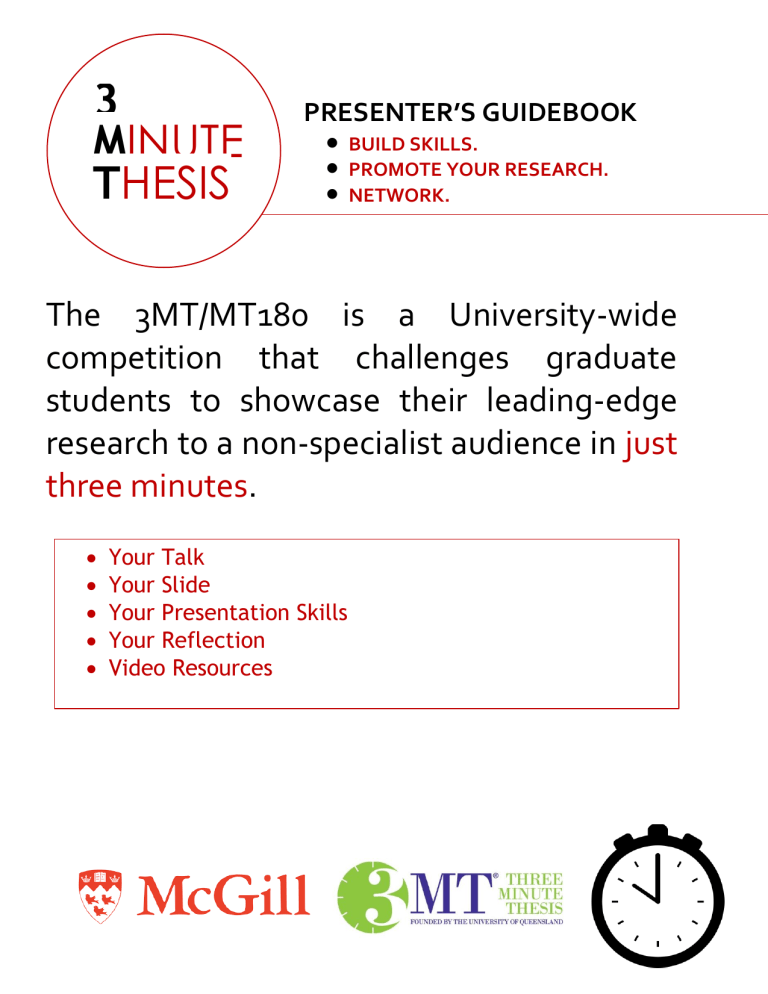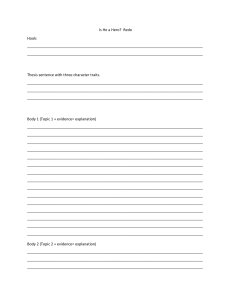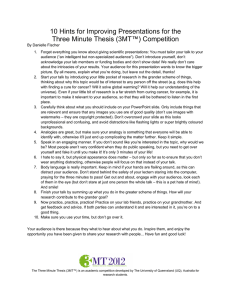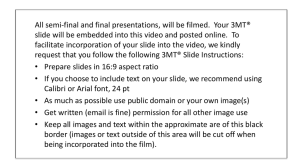
3 MINUTE THESIS PRESENTER’S GUIDEBOOK BUILD SKILLS. PROMOTE YOUR RESEARCH. NETWORK. The 3MT/MT180 is a University-wide competition that challenges graduate students to showcase their leading-edge research to a non-specialist audience in just three minutes. Your Talk Your Slide Your Presentation Skills Your Reflection Video Resources 3 MINUTE THESIS Your talk. Content Less is more! Focus on three key messages at most. Separate content into small sections using signposts (e.g., First, And then, Now, On to my next point, in other words, etc.). These help the audience follow along. Use short sentences (25 words max). Use pauses and chunking (put emphasis on the last content word of a phrase). o E.g., “Why would you go to school / when you could stay home / and stay in bed?” Use active voice. o E.g., “I wanted to find out…; we created a tool to fix…" instead of “a tool was created” Avoid jargon and explain key terms in non-specialist language. Explain concepts and people important to your research - you may know all about Professor Smith’s theories but your audience may not. Highlight the outcomes of your research, and the desired outcome. Imagine that you are explaining your research to a close friend or fellow student from another field. Convey your excitement and enthusiasm for your subject. Consider presenting your 3MT as a narrative, with a beginning, middle and end. Break your presentation down into smaller sections to make it easier to follow Structure 1. Introduction a. Capture the audience’s attention at the start with a hook (e.g. ask a question, tell a story, give a contemporary example). b. Introduce yourself briefly after your hook. 2. Body (your research) a. Provide context/background of your research. b. Keep the messages simple. c. Articulate the significance of your research for society. d. Use examples that the audience will relate to. 3. Conclusion a. Return to your introduction to close your talk. b. End on a high note. c. Thank the audience! d. Remember to keep it under 3 minutes or you will be eliminated from the competition – practice! 3 MINUTE THESIS Your slide. Background Leave white/light space Use colours that work well on a screen Don’t overcrowd your slide Be creative Make sure your slide is legible, clear and concise. Imagines & Figures Use high quality images Re-size and compress images before inserting them on the slide Use simple graphics to convey important information Text Use min. 24-point font size and a sans serif font type Make sure all your test is in your language of presentation Content Only include relevant content that you actually refer to in your presentation Use minimal, if any, text. Include your name in a bottom corner Do not rely on your slide to convey your message – it should simply complement your oration. Think about how your slide might be able to assist with the format and delivery of your presentation – is there a metaphor that helps explain your research? Personal touches can allow your audience to understand the impact of your research. 3 MINUTE THESIS Your presentation. Pacing Speak at a reasonable pace (average roughly 150 words/minute) Avoid “ums”, “ahs” and “ers” Silent Pauses Why you should use them: o To collect your thoughts o You appear in control and confident o To give the audience time to process your message How to use them: o Before starting your talk o When you transition from one point to the next o After an important point, for emphasis o After posing a rhetorical question Body Language Have a confident stance Don’t fidget or have your hands in your pockets Be expressive with your body Smile and make eye contact with the whole audience Be enthusiastic and show your passion Dress professionally Have a clear outcome in mind Know what you want your audience to take away from your presentation. Try to leave the audience with an understanding of what you’re doing, why it is important, and what you hope to achieve. Revise Proof your 3MT presentation by reading it aloud, to yourself and to an audience of friends and family. Ask for feedback. Ask your audience if your presentation clearly highlights what your research is about and why it is important. 3 MINUTE THESIS Your reflection. Checklist • • • • • • • • • • • • • • • Did you introduce yourself? Were you explicit about your take-away message? Did you speak in short sentences so that the audience can follow the ideas easily? Did you use vocabulary that your audience can understand, i.e., limited use of field-specific jargon? Did you use discourse markers/signposts to guide the audience through the talk? Did you support your claim with examples and/or evidence? Did you face the audience? Did you scan the audience to establish eye contact? Did you speak fluently without making hesitation sounds? Did you speak at a pace that allows the audience to digest the ideas? (aim for 150 words per minute) Did you speak loudly enough for people at the back of the room to hear? (n/a if speakers have microphones) \ Did you exhibit nervous behaviours? Did you use visual to support your words? Did you thank the audience for listening/for their attention? Did you appear prepared? Video Resources In Jay Olson’s Three Minutes to Change the World talk, he pulls the audience in with an interactive hook. Link Using humour, like in Jeremie Abitbol’s talk is a great way to hook your audience. Remember, you may have to repeat the joke several times as you practise. Link Practise out loud and make sure you don’t go over 3 minutes. Aim for 2 minutes and 50 seconds, like Danielle Dobney has. Link Speak slowly; plan your pauses, your hand gestures and your body language, as demonstrated in Lauren Godfrey-Smith’s talk. Link Make it personal and relevant to yourself and your audience, as 3MT competitor, Marzieh Ghiasi, has done. Link Have fun and be passionate like past competitor, Pierre Lubin! If you are enjoying doing the presentation, the audience will enjoy hearing you talk. Link



